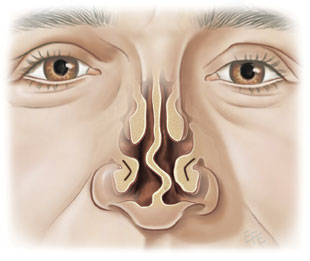 |
|||||||||||||||
|
|
 |
 |
|||||
Intranasal Surgery
One or more of the following procedures may be done:
Septoplasty A septoplasty is an operation aimed at making it easier for you to breathe through the nostrils. It is normal to be able to freely breathe through the nostrils. The most common cause of a blockage is a deviated nasal septum. That is the cartilage part dividing the nose is buckled, either by trauma or by uneven growth. The operation is performed through the nostril. There is a small invisible incision just inside the nostril. This will be stitched and the stitches will dissolve. Cartilage and bone are removed, straightened and replaced. The operation takes about 30 minutes, usually under general anaesthetic. Will my nose be packed? Probably not. However if bleeding is excessive a dressing of gauze or haemostatic wool will be inserted for 12 hours or so.
What can I expect? For the first 10 days your nose will be stuffy, like you have a bad cold. Pain is usually not severe but headache can occur for up to 1 week post operatively. Paracetamol and codeine should be all that is necessary. Plastic splints are often inserted at the time of operation. These will be removed after the first 5 - 7 days. The nose is usually clear once these have been removed. Three weeks later there is another postoperative visit. By this time most of the healing process will have occurred but one can expect steady improvement in the nasal breathing for about 6 weeks after surgery. How long will I be in hospital? If your operation is done early morning, you may be able to go home the same evening. Expect to stay overnight. Occasionally a stay of 2 days is necessary if there is too much discomfort or bleeding.
Turbinectomy Turbinates are part of the air conditioning structure of the nose. When the turbinates swell excessively the nose will block. A turbinectomy may be combined with a septoplasty in order to provide a clearer nasal passage. Will the nose bleed? There will be some bleeding, particularly during the first 24 hours but is usually slight. A small sling of nasal gauze is worn under the nose to absorb this ooze. This can be present for up to 1 week. Occasionally, a secondary haemorrage (bleed) can occur up to 14 days following surgery. If this occurs, please notify Mr Nicholson or your local doctor as soon as possible. Occasionally such bleeding needs to be controlled in hospital, rarely is a blood transfusion needed.
What other risks are there? Infections can occur in the sinuses. Local infection in the nose can cause crust and scab formation. Antibiotics are normally prescribed for the first week. A wash of weak salt and water solution will clear and dry the nose and is recommended in the second and third weeks after surgery. Patients do not usually suffer black eyes.
Nasal Polypectomy The lining of the nose responds to various noxious stimuli by swelling e.g. hay fever. This is a common form of allergy, especially to dust, pollen, animal fur etc. Temperature changes and humidity will affect the nasal passage. Infections may also cause this. If the lining of the nose swells too much, polyps hang down into the nose (like grapes) and will cause blockage. Polyps usually come from the ethmoid sinus, which is between the eyes. A polypectomy - removal of polyps, is performed to clear the nose. This is done under local anaesthetic depending on the severity of the blockage. Instructions for Surgery for Nasal Surgery You may also refer to the Preparing for Surgery patient information sheet. FASTING: (food & liquid) from midnight for a morning operation and from 7.30am for an afternoon operation, a light breakfast of tea and toast is OK prior to 7.30am. Children under 14 may have clear fluids only up until 10.30am, (NO MILK) but definitely nothing after 10.30am. FORMS: Hospital admission forms and anaesthetic forms should be completed and returned to the hospital at least 3 days prior to the date of your operation. If you have any queries regarding your operation please do not hesitate to contact Dr Nicholson’s rooms. No Aspirin Or Aspirin Containing Pain Killers To Be Taken 2 Weeks Prior To Surgery
Post operative care for Nasal Surgery Rest at home for 5 -10 days. This reduces the risk of infection and bleeding. Do not attempt to blow the nose forcibly until you have seen Dr Nicholson following surgery. The nose will drip for about 10 days and usually remains blocked for 10 days or longer. Expect blood stained mucus and old blood from the nose for the first 10 days. Brisk bleeding, fever or increased pain should be reported to Dr Nicholson immediately. A small gauze dressing under the nose will absorb excess mucus. Pain and headache - if not eased by simple relievers such as paracetamol or codeine, seek medical advice. Dissolve 1 desert spoon full of bicarbonate soda in 1 pint of water. Allow to cool until tepid. Fill a glass to the brim, and then gently suck this fluid into the nose. This will help clear old blood. Do this in the second postoperative week. *These notes are an outline only and should be expanded on in discussion with Dr Nicholson. |
The patient information sheets are intended as a guide only and not to take the place of a full discussion of this procedure with Dr Nicholson |
|||||
|
|
|||||
|
